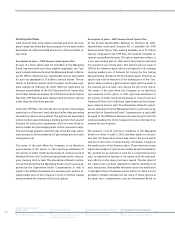Siemens 2009 Annual Report Download - page 283
Download and view the complete annual report
Please find page 283 of the 2009 Siemens annual report below. You can navigate through the pages in the report by either clicking on the pages listed below, or by using the keyword search tool below to find specific information within the annual report.
Managing Board statements, Independent auditors’ report, Additional information
Notes to Consolidated Financial Statements
(in millions of €, except where otherwise
stated and per share amounts)
ment, the assumption is that investments in foreign-based op-
erations are permanent and that reinvestment is continuous.
Whenever a divestment of a particular asset or entity is made,
the value of this transaction risk related to this divestment is
considered in the VaR analysis. Effects from currency fluctua-
tions on the translation of net asset amounts into Euro are re-
flected in the Company ’s consolidated equity position.
Interest rate risk
Siemens’ interest rate risk exposure is mainly related to debt
obligations like bonds, loans, commercial paper programs and
interest-bearing deposits and investments. Siemens seeks to
limit this risk through the use of derivative instruments which
allow it to hedge fair value changes by swapping fixed rates of
interest into variable rates of interest. For additional informa-
tion see Note 32.
To optimize the Company ’s position with regard to interest in-
come and interest expenses and to minimize the overall finan-
cial interest rate risk, Corporate Treasury performs corporate
interest rate risk management together with SFS as operating
service provider. Part of the interest rate risk management
concept is a Corporate-wide interest rate overlay management
to match interest periods of hedges with intended maturities
of assets and liabilities. Where it is not contrary to country-
specific regulations, all Siemens segments, entities and affili-
ated companies generally obtain any required financing
through Corporate Treasury in the form of loans or intercom-
pany clearing accounts. The same concept is adopted for de-
posits of cash generated by the units.
Interest rate risk is measured by using a parametric variance-
covariance value at risk (VaR) approach. The VaR concept
quantifies the market risk calculated against a fictive overnight
financing benchmark.
Assuming historical volatilities and correlations, a 10 day hold-
ing period and a confidence level of 99.5 percent the interest
rate value at risk (VaR) was €33 as of September 30, 2009, de-
creasing from the comparable value of €54 as of September 30,
2008. This interest rate risk results primarily from long-term
fixed rate debt obligations and interest-bearing investments.
actions in the global financial markets are carried out by SFS as
exclusive service provider for almost all Siemens’ entities on
behalf of Corporate Treasury. SFS executes as operating ser-
vice provider for Corporate Treasury hedging instruments for
hedge accounting with external counterparts whereas for
other hedging purposes Siemens has a Company-wide portfo-
lio approach which generate a benefit from any potential off-
set of divergent cash flows in the same currency, as well as op-
timized transaction costs. For additional information relating
to the effect of this Company-wide portfolio approach on the
Consolidated Financial Statements, as well as for a discussion
of hedging activities employed to mitigate or reduce foreign
currency exchange risks, see Note 32.
The value at risk (VaR) for foreign exchange rates is calculated
by aggregation of the net foreign exchange rate exposure. The
figures disclosed here are based on the net foreign exchange
positions after hedging. As of September 30, 2009 the foreign
exchange rate risk based on historical volatilities and correla-
tions, a 10 day holding period and a confidence level of 99.5
percent resulted in a VaR of €12 million compared to a VaR of
€31 million in the year before. Changes in Euro values of future
cash flows due to volatile exchange rates might influence the
unhedged portion of revenues, but would also affect the un-
hedged portion of cost of materials. Future changes in the for-
eign exchange rates can impact sales prices and may lead to
margin changes, the extent of which is determined by the
matching of foreign currency revenues and expenses.
Siemens defines foreign exchange rate exposure generally as
balance sheet items in addition to firm commitments which
are denominated in foreign currencies, as well as foreign cur-
rency denominated cash inflows and cash outflows from an-
ticipated transactions for the following three months. This for-
eign currency exposure is determined based on the respective
functional currencies of the exposed Siemens’ entities.
Effects of currency translation
Many Siemens’ subsidiaries are located outside the Euro zone.
Since the financial reporting currency of Siemens is the Euro,
the financial statements of these subsidiaries are translated
into Euro so that their financial results can be included in the
Consolidated Financial Statements of Siemens. To consider the
effects of foreign exchange translation risk in the risk manage-
























